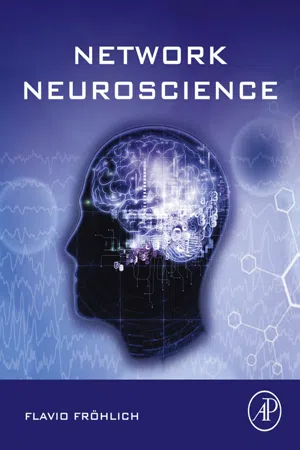
- 482 pages
- English
- ePUB (mobile friendly)
- Available on iOS & Android
Network Neuroscience
About This Book
Studying brain networks has become a truly interdisciplinary endeavor, attracting students and seasoned researchers alike from a wide variety of academic backgrounds. What has been lacking is an introductory textbook that brings together the different fields and provides a gentle introduction to the major concepts and findings in the emerging field of network neuroscience. Network Neuroscience is a one-stop-shop that is of equal use to the neurobiologist, who is interested in understanding the quantitative methods employed in network neuroscience, and to the physicist or engineer, who is interested in neuroscience applications of mathematical and engineering tools. The book spans 27 chapters that cover everything from individual cells all the way to complex network disorders such as depression and autism spectrum disorders. An additional 12 toolboxes provide the necessary background for making network neuroscience accessible independent of the reader's background.
Dr. Flavio Frohlich wrote this book based on his experience of mentoring dozens of trainees in the Frohlich Lab, from undergraduate students to senior researchers. The Frohlich lab pursues a unique and integrated vision that combines computer simulations, animal model studies, human studies, and clinical trials with the goal of developing novel brain stimulation treatments for psychiatric disorders. The book is based on a course he teaches at UNC that has attracted trainees from many different departments, including neuroscience, biomedical engineering, psychology, cell biology, physiology, neurology, and psychiatry. Dr. Frohlich has consistently received rave reviews for his teaching. With this book he hopes to make his integrated view of neuroscience available to trainees and researchers on a global scale. His goal is to make the book the training manual for the next generation of (network) neuroscientists, who will be fusing biology, engineering, and medicine to unravel the big questions about the brain and to revolutionize psychiatry and neurology.
- Easy-to-read, comprehensive introduction to the emerging field of network neuroscience
- Includes 27 chapters packed with information on topics from single neurons to complex network disorders such as depression and autism
- Features 12 toolboxes serve as primers to provide essential background knowledge in the fields of biology, mathematics, engineering, and physics
Frequently asked questions
Information
Toolbox Neurons
Blueprint of a Neuron

Dendrites
Table of contents
- Cover image
- Title page
- Table of Contents
- Copyright
- Dedication
- Preface
- Introduction
- Introduction
- Unit I. Neurons, Synapses, and Circuits
- Introduction
- Unit II. Measuring, Perturbing, and Analyzing Brain Networks
- Introduction
- Unit III. Cortical Oscillations
- Introduction
- Unit IV. Network Disorders
- Introduction
- Unit V. Toolboxes
- Index